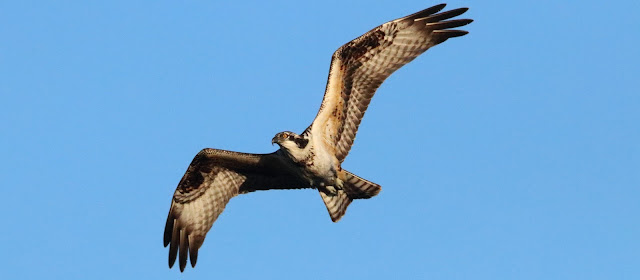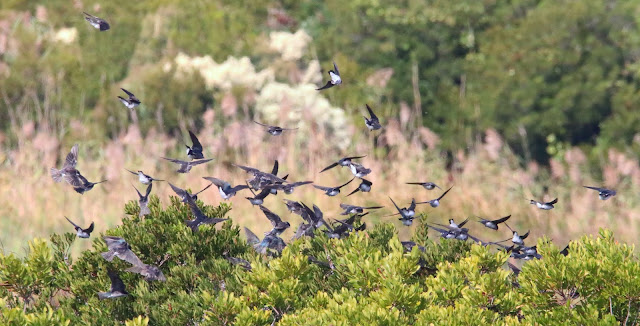Cape May, New Jersey
28 September – 1 October 2017
This time of year I watch the passage of weather systems. When I see the impending
arrival of a cold front, bringing with it northwest winds and a drop in temperature, I
head to Cape May, New Jersey, to watch migrating raptors, songbirds, and butterflies.
Cape May is famed for its autumn passage of hawks, falcons, and Monarch butterflies.
Cape May, of course, has long been a summer beach resort, and these days its autumn
tourism is considerable, because of various festivals, an array of excellent restaurants,
and of course the lovely combination of benign Indian summer weather, history, and
outdoor recreational activities that include birding, fishing, and bicycling.
Osprey
Cape May is home to the Cape May Bird Observatory, an affiliate of New Jersey Audubon. The Observatory operates a bookstore, a Monarch butterfly program, and a world famous hawk-watch. Many nature-loving people migrate to Cape May in the autumn to take part in these nature-focused activities.
male American Kestrel
The northwest winds carry both nocturnal songbird migrants as well as diurnal migrating raptors down the peninsula, where they are concentrated at southward-facing Cape May Point, with the Atlantic to the east and the Delaware Bay to the west. Since most birds avoid making major crossings of salt water, Cape May point sees a remarkable swirling-about of the migrant birds when they reach this terrestrial dead end. A few, such as Ospreys, Bald Eagles, and Peregrine Falcons, after a brief pause, will brave the elements and cross Delaware Bay southwestward to Cape Henlopen, Delaware. The much larger portion of the migrant birds, afraid of the expanse of water, will instead travel northwestward up the western shore of the Cape and seek a shorter water crossing where Delaware Bay is not so broad. So what happens is the migrants arrive in the cul-de-sac of Cape May point, swirl about, rest, feed, and then make their way back into the headwinds to continue their journey (going north, west, and then south to get on the west side of Delaware Bay).
Peregrine Falcon juvenile
Many songbirds, which migrate at night, find, when the sun comes up, that they have been carried offshore by the prevailing northwest winds. They then about-face, head into the wind, and return to the safety of terra firma. These birds may rest briefly, but then in the morning rise up and fly northward to continue their migration trek. All of these movements give birders an opportunity to see large numbers of birds on the move. This weekend was no exception. Over a four-day period I saw thousands of migrating birds of more than eighty species.
This year, my drive from Bethesda, Maryland, to Cape May took about four hours, traveling up route 95 to Baltimore and then Wilmington, crossing the Delaware Memorial Bridge before turning southeastward on smaller roads down to the southern tip of New Jersey. Another option is to drive to Lewes, Delaware, and then take the auto-ferry across Delaware Bay to Cape May. The latter route typically takes about an hour longer, but avoids the traffic bottlenecks on route 95 and the Delaware Memorial Bridge.
Sharp-shinned Hawk
I arrived and set up camp at the Depot Travel Park right in Cape May proper. I camped under tall Sweet Gums and Oaks, and my camping spot was only five minutes’ drive from the hawk watch platform at Cape May Point State Park. The Depot is populated mainly by RVs, many of which appear to be kept in place the year-round. But happily there is a patch of woods in the back of the park where there are about 20 sites suitable for drive-in tent-camping—perfect for my needs.
American Kestrel
After setting up, I headed directly to the hawk watch platform to see what was happening. There were probably 50 people on the platform when I arrived around 3 pm. This day was an American Kestrel day, with 1,936 of these little falcons passing by the platform. This was the high count for any of the 11 species of raptors that passed by this day. It seemed that kestrels were everywhere in the afternoon, zipping here and there. But there were good numbers of the two larger falcons as well that day—46 Peregrines and 146 Merlins. A major falcon day!
Merlin
The hawk watch platform is where birders come from all over the US to see raptors in numbers, and where the Cape May Bird Observatory staff make a daily count of birds. This weekend, it was Erik Bruhnke who was in charge of the count, assisted by a crew of others, who had various duties, including shouting out bird identifications and helping the visiting birders actually pin-point the raptors as they passed by. It is quite a festive occasion on the platform, with the group oohing and ahhing as great birds performed overhead. This is the place to be on a day in late September or early October when the hawks, falcons, eagles, and harriers are passing by in the northwest wind.
Mute Swan
I typically start the day at the Coral Avenue dune overlook, southwest of the hawk watch (usually at the advice of Louise Zemaitis and Michael O’Brien, my Cape May birding gurus). On Friday morning, Coral Avenue was quiet, so Louise recommended that I head up to Cape May County Park South (near Norbury’s Landing)—north up the western shore of the Cape about ten miles. There I found Michael O’Brien and Don Freiday, plus Timothy Freiday, Hannah Greenburg, and Kelley Nunn, counting landbirds moving north up the coast of Delaware Bay, pushing into the headwinds. Over a period of four hours, the group recorded 76 species of birds, totaling 8,815 individuals. I, myself, was only there for the final 75 minutes, and identified only a small number of the birds that raced by in the wind. I was struggling to photograph the birds in flight with my new zoom lens.
Northern Harrier
O’Brien’s ability to identify warblers in flight (by shape and flight note) is astounding. He recorded 75 Cape May Warblers that morning, as well as 35 Blackpolls, 3 Bay-breasts, and 1 Connecticut. In all, he and Don tallied 20 species of warblers passing by. The most astounding sighting, however, was the hoard of 2,378 Northern Flickers that they counted. Who has ever seen that many woodpeckers in a single morning? I had seen four flickers pass overhead at dawn at my campsite earlier that morning, but had no idea what a flicker day it would be....
Northern Flicker
Friday produced 213 Broad-winged Hawks at the Cape May hawk watch as well as 64 Ospreys and 78 Peregrines, and 18 Bald Eagles.
juvenile Bald Eagle
Broad-wings tend to migrate along the Appalachians, so it is a surprise to see so many out here along the coast.
Broad-winged Hawk
I wandered the woods and dunes of Cape May Point State Park and bumped into all sorts of wildlife:
Monarchs at goldenrod...
As well as lots of Buckeyes...
Also a lone Bobwhite quail—apparently the product of a local reintroduction effort.
On Saturday morning, I spent some time at Coral Avenue, where I saw Black Scoters in the surf (below)...
As well as 9 Lesser Black-backed Gulls on the beach—a good number for this formerly rare species.
Lesser and Great Black-backed Gulls
Ospreys seemed to be everywhere this weekend, lazily circling abound, planning their bay crossing.
One Osprey with a fish came lumbering in off the Bay only to be discovered by a hungry adult Bald Eagle, who chased the Osprey until the hapless fisher gave up its meal.
Bald Eagle chasing down an Osprey with a fish
Another autumn phenomenon is the flocking of Tree Swallows. This I encountered in the dune vegetation east of the hawk watch at Cape May State Park. Later in the autumn, the flocks can swell into the thousands, swirling about in the winds.
Tree Swallow flocks
Mute Swans continue to inhabit southern New Jersey, in spite of their bad reputation—they are an exotic invasive species (and yet very beautiful and very large).
Mute Swans
Sunday morning, I visited Saint Peter’s dune crossing on Cape May Point, adjacent to Coral Avenue, to witness the large cluster of migratory Monarch Butterflies roosting in the pines. The Monarchs awake when the sun hits the trees and then they flutter off on their long migration south and west. I had never seen 300 Monarchs in a roost before, and I was not the only one entranced by this morning spectacle. The good news is after several poor years with few Monarchs at Cape May, this year has seen great numbers. It’s great to have them back!
























Great series of images from a legendary location.
ReplyDelete